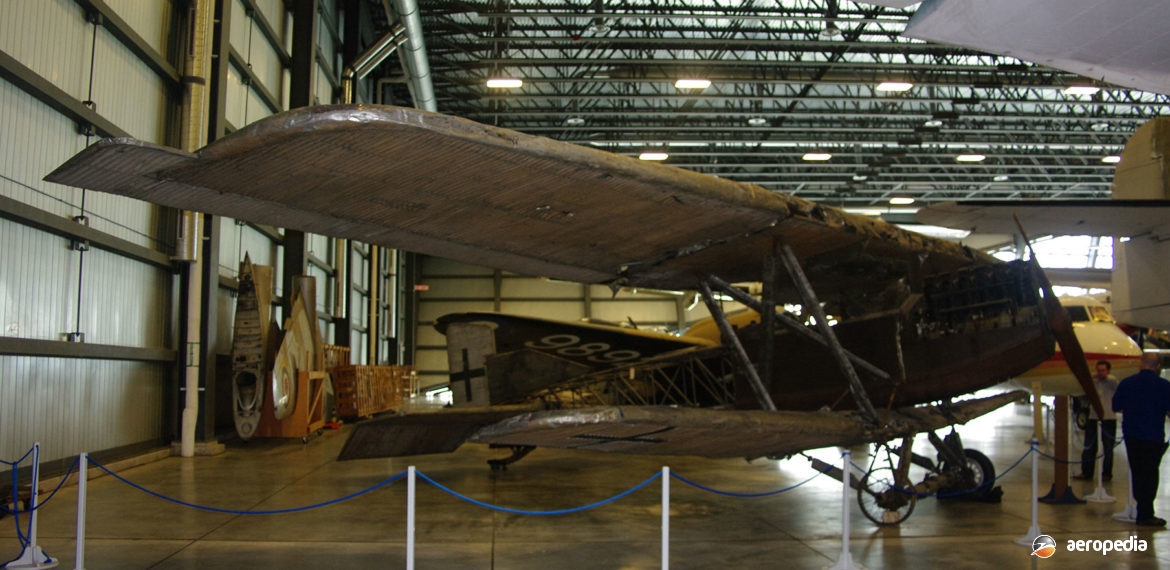Photograph:
Junkers J 1 serial 586/17 captured by Canadian forces in World War I and now on display in Ottawa, Canada in September 2009 (David C Eyre)
Country of origin:
Germany
Description:
Single-seat fighting scout
Power Plant:
One 149 kw (200 hp) Benz Bz IV six-cylinder in-line liquid-cooled engine
Specifications:
- Wingspan: 16 m (52 ft 6 in)
- Length: 9.1 m (29 ft 10⅜ in)
- Height: 3.4 m (11 ft 1⅝ in)
- Wing area: 49.4 m² (533.52 sq ft)
- Max speed: 155 km/h (97 mph)
- Climb to 2,000 m (6,560 ft): 32 mins
- Endurance: 2 hours
- Fuel capacity: 120 litres (26.4 Imp gals)
- Empty weight: 1,766 kg (3,885 lb)
- Loaded weight: 2,176 kg (4,787 lb)
- Armour weight: 470 kg (1,040 lb)
History:
It seems there were two Junkers J 1 aircraft, the first, the Blechesel, known as the ‘Tin Donkey’ or ‘Sheet Metal Donkey’, being the world’s first practical all-metal monoplane, appearing at the beginning of World War I in 1915. It was what was described as a revolutionary development in aircraft design. It should not be confused with the later all-metal Junkers J 4 sesquiplane, which carried armour for the crew, and which was accepted by the Luftstreitkrafte as the Junkers J I, using a Roman numeral rather than the figure ‘1’.
German authorities were impressed with Junkers’ form of construction and sought an armoured biplane, this being designed by Professor Madelung. It was completed and flown on 28 January 1917 for the first time. It was somewhat unusual for the time, with corrugated sheet covering being used, it being alloy riveted to a dural airframe.
The aircraft was of an unorthodox layout and had a small lower cantilever wing combined with a hexagonal-shaped fuselage. The nose was completely armoured with 5 mm chrome-nickel sheet steel which enclosed the engine and crew compartment, this having a solid bulkhead to give the crew further protection. The rear part of the fuselage consisted of an alloy tube frame and this was fabric covered, although late build aircraft had a corrugated metal skin. The prototype had a triangular fin and an unbalanced rudder but this was re-designed on production aircraft.
The upperwing was built in three panels, the centre-section being of constant chord. The aircraft had ailerons extending the whole length of the outer panels. Construction was of tubular dural spars to which were riveted tubular diagonals and this formed a Warren girder-type rib skeleton. The Benz engine was fitted with high-compression cylinders and was completely enclosed in the armoured capsule.
The aircraft entered service in 1917 and although it was considered revolutionary, it was very strong and well suited for the operations proposed for it. It operated at low altitude and the observer reported the situation to the rear command post by radio, sometimes by message bags.
A total of 227 J 1s was constructed. At least one example was shot down, this being hit by a French anti-aircraft machine gun firing armour-piercing rounds. It is believed to be the only one lost in action, others being damaged in landing and other mishaps.
One example was captured by No 4 Squadron, Australian Flying Corps, at Bickendorf on the Western Front in 1919. Serialled 884/17 it is believed it was flown by at least one pilot of the Squadron and was one of a number of captured aircraft put aside to be shipped to Australia as a museum piece. However, it seems that the cost of shipping all of the aircraft earmarked for transport to Australia was considered exorbitant. It was not shipped and it is believed it was eventually broken up.
One example of the J 1 (serial 586/17 – c/n 252) has survived in the Canada Aviation and Space Museum in Ontario, Canada, this being captured as a war trophy and being shipped to Canada in 1919. The fuselage of another has survived at the Science & Technology Museum in Milan, Italy.

